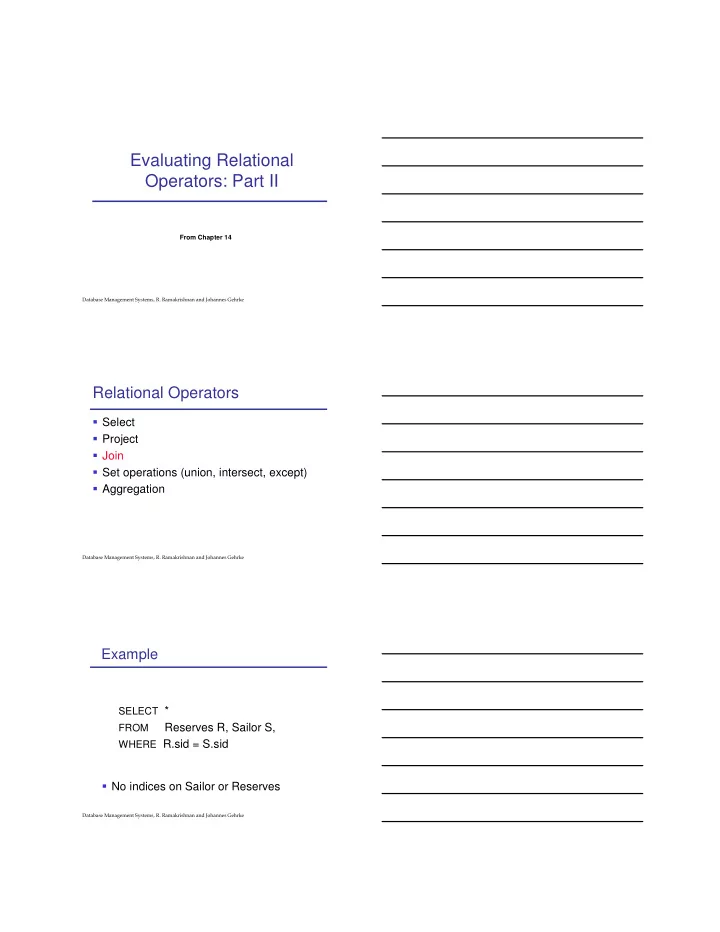

Evaluating Relational Operators: Part II From Chapter 14 �������������������������������������������� ������������������� Relational Operators � Select � Project � Join � Set operations (union, intersect, except) � Aggregation �������������������������������������������� ������������������� Example SELECT * Reserves R, Sailor S, FROM WHERE R.sid = S.sid � No indices on Sailor or Reserves �������������������������������������������� �������������������
Tuple Nested Loop Join ������� ����� ��������� ������� ����� ��������� �������� �������� �������������� ���������� � R is “outer” relation � S is “inner” relation �������������������������������������������� ������������������� Analysis � Assume � M pages in R, p R tuples per page � M = 1000, p R = 100 � N pages in S, p S tuples per page � N = 500, p S = 80 � Total cost = ___________ � #��������������$����������������� � �������������%����������� � ������������!������������"������� �������� �������������������������������������������� ������������������� Page Nested Loops Join ������� ������&�������� ������� ������'�������� ������� ������&��� ������� ������'������������� �������� �������� �������������� ���������� � R is “outer” relation � S is “inner” relation �������������������������������������������� �������������������
Analysis � Assume � M pages in R, p R tuples per page � M = 1000, p R = 100 � N pages in S, p S tuples per page � N = 500, p S = 80 � Total cost = _________ � (���!�))))))))��������������������*�����+ � ,����������))�������*�����+ ������������- � ������������!������������������������������ �������������������������������������������� ������������������� Block Nested Loops Join � Use one page as an input buffer for scanning the inner S, one page as the output buffer, and use all remaining pages to hold ``block ’’ of outer R. � For each matching tuple r in R-block, s in S-page, add <r, s> to result. Then read next R-block, scan S, etc. ��.�� ����������� Hash table for block of R (k < B-1 pages) ����� ����� ����� Input buffer for S Output buffer �������������������������������������������� ������������������� Analysis � Assume � M pages in R, p R tuples per page � M = 1000, p R = 100 � N pages in S, p S tuples per page � N = 500, p S = 80 � BS is the block size � Total cost = __________ � With sequential reads , analysis changes: may be best to divide buffers evenly between R and S. �������������������������������������������� �������������������
Example SELECT * Reserves R, Sailor S, FROM WHERE R.sid = S.sid � No indices on Sailor or Reserves �������������������������������������������� ������������������� Sort-Merge Join � Sort R on the join attributes � Sort S on the join attributes � Merge sorted relations to produce join result � Advance r in R until r.sid >= s.sid � Advance s in S until s.sid >= r.sid � If r.sid = s.sid � All R tuples with same value as r.sid is current R group � All S tuples with same value as s.sid is current S group � Output all <rg, sg> pairs, where rg is in current R group, sg is in current S group � Repeat �������������������������������������������� ������������������� Example of Sort-Merge Join sid bid day rname sid sname rating age 28 103 12/4/96 guppy 22 dustin 7 45.0 28 103 11/3/96 yuppy 28 yuppy 9 35.0 31 101 10/10/96 dustin 31 lubber 8 55.5 31 102 10/12/96 lubber 44 guppy 5 35.0 31 101 10/11/96 lubber 58 rusty 10 35.0 58 103 11/12/96 dustin �������������������������������������������� �������������������
Analysis � Assume � M pages in R, p R tuples per page � M = 1000, p R = 100 � N pages in S, p S tuples per page � N = 500, p S = 80 � Total cost = � Note: (M + N) could be (M * N) in worst case � With 300 buffer pages, R and S sorted in __ passes � Sort-merge join cost: ________ � BNL join cost: _______ �������������������������������������������� ������������������� Refinement of Sort-Merge Join � We can combine the merging phases in the sorting of R and S with the merging required for the join. ������� M/2B Runs of R ����� ������� ����� ����� ������ N/2B Runs ��������� of S ���� ���� ��������������������� � ��/��������!��0',�1�(0',����,�2 & �������������������������������������������� ������������������� Analysis � Assume � M pages in R, p R tuples per page � M = 1000, p R = 100 � N pages in S, p S tuples per page Select � N = 500, p S = 80 � Total cost = __________ � 3�����&!�)))))))))))� � 3�����'!�))))))))))) �������������������������������������������� �������������������
Example SELECT * Reserves R, Sailor S, FROM WHERE R.sid = S.sid � No indices on Sailor or Reserves �������������������������������������������� ������������������� Original Hash-Join Relation OUTPUT Partitions 1 1 � Partition both 2 INPUT 2 relations using hash hash ����� function fn h : R tuples in h B-1 partition i will only B-1 match S tuples in Disk B main memory buffers Disk partition i. Partitions Join Result of R & S Hash table for partition � �������������������� Ri (k < B-1 pages) hash �������������������� fn h2 ���������� ������� ������������������� h2 ����������������� Input buffer Output for Si buffer �������� B main memory buffers Disk Disk �������������������������������������������� ������������������� Analysis (without recursive partitioning) � Assume � M pages in R, p R tuples per page � M = 1000, p R = 100 � N pages in S, p S tuples per page � N = 500, p S = 80 � Total cost = __________ � 3�����&!�)))))))))) � 3�����'!�)))))))))) � ��/��������!��04,�2 &5����,�2 ' �������������������������������������������� �������������������
Recommend
More recommend